The other day, I was leaning back in my chair, hands clasped behind my head, running through a quick mental inventory of things I know, and areas of knowledge I may still need to explore. I instantly recalled that Slap Maxwell had a girlfriend named Judy, yet I completely drew a blank on a practical approach to building a particle accelerator. And so it goes with my interest in firearms; I can handload, I can shoot my guns, I can even construct some simple but superficial tools to play with, but if I can’t locate a real tool, fixture, gage, or small part in a catalog, I’m pretty much out of luck.
Good metal working gunsmiths, much like a lot of other firearm related crafts people, are becoming more difficult to find. No, I don’t think this is the result of an insidious anti gun plot, but it may be the result of misguided environmentalist who have pretty much gutted the country’s manufacturing base, along with its machinery, training, talent and experience. The factories are gone, the jobs are gone, the skill is gone, yet a swelling population insures areas of concentrated air and water pollution remain in place, and whatever pollution isn’t produced here, gets to us through winds aloft from the countries that now have our jobs, machines, products, etc…. Perhaps we should have put the effort into cleaning up the process rather than throwing it away. I know, quite a soap box, but I was trying to illustrate irony.
Highly skilled gunsmiths do exist, but they are taking care of business first. In a world where a cut taken with a milling machine can result in a $5,000 custom rifle, as easily as a $25 replacement part, the custom rifle will win out every time as a service that is provided. So the trick to is to feed an active interest in firearms, with diminished access to critical resources. I have a decent work area, and I have a set of power tools, bench and floor standing, that have done well in meeting routine fabrication needs. What’s missing is the capability to turn and mill material, equipment as well as the necessary skill. I felt if I could take care of the machinery, I would be able to practice and eventually take care of the other deficiency. Yeah, I know, me and 5,000 other guys with a basement or garage full of idle and rusting machinery. But I’m different….honest.
The Lathe

I thought I’d begin looking for a lathe, nothing big, nothing fancy, just something I could use to turn small precise parts, parts that might eventually resemble my yellow legal pad design scratches.
I started with a 9″ x20″ Jet, probably because I own one of their drill presses, and because the one I saw on local display looked okay. After some analysis, I found this to be an OEM Asian product, differing only in minor features and paint color from brands such as Enco and Grizzly. The additional cost of this proprietary Jet beige paint is about $300 more than simple green, blue or red.
Lathe sizes generally use a common set of descriptions, but not always. A 9″x20″ lathe typically means a 9″ swing over bed, but only a little over 5″ over the cross slide, which is the more practical limiting factor. The 20″ designation is typically the distance between centers, tailstock to headstock. The 20″ limit may not be a problem for chambering a barrel, the barrel is typically passed through the hole in the spindle that holds the chuck, but the largest spindle bore I was able to locate on either bench top or mini lathes was 20mm, about .788″ and too small for a typical rifle barrel. My conclusion was I couldn’t get there from here, I would need a larger lathe to accomplish rifle barrel work, a machine of this type would probably be an overkill for a lot of precision small parts work, and these lathes don’t offer all of the features of slightly larger machines intended for commercial applications.
I decided I would concentrate on projects comprised of small parts production, and save a larger machine purchase for a time when I would have accumulated experience and developed some legitimate lathe skills, had better defined the projects I would undertake, and could make a more informed purchasing decision on a piece of equipment of significantly greater cost.
Micro & Mini Lathes

There are lots of small lathes out there, most seemingly designed to produce reasonably precise parts, which fall into roughly three broad categories; American made micro lathes, Asian made mini lathes and really expensive German mini lathes.
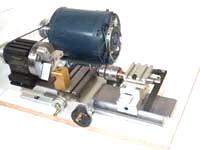
Micro lathes, such as the T aigon the left, and the Sherline top left photo, are precise and capable machines, maybe leaning a little more toward small model making. Micro lathes are typically delivered ready to run, but are modular in design, with components and accessories selected or declined based upon intended use.
In the most basic configurations, these lathes can perform simple turning on a variety of materials, some of the more elaborate configurations encompass full computer controlled turning and milling capability. Basic model prices fall into the $400 range, the more elaborate control set ups in excess of $2,500. A configuration that might have been useful to me, probably in the $900 range inclusive of needed accessories. I concluded the Taig had insufficient capacity for my purposes, and I stopped pursuing Sherline when I read a passage on their site that explained that they were able to offer their product at a low price by avoiding expensive grinding and heat treating, which I interpreted as holding price by sacrificing production accuracy and machine durability.
Yes, I’ve seen some of the elaborate miniature parts and assemblies produced from both of these machines, however, I believe this requires an operator with a good deal of skill, read that “not me”, to accomplish this quality level of output.
Prazi – designer label lathes ?
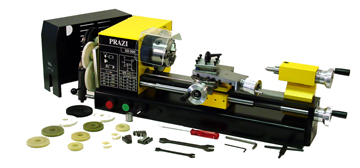
There is one lathe nobody seems to mention much within Internet discussion groups, so I will mention it briefly, then move on. The Prazi, in several forms, is listed as a German made, high precision lathe.
The SD300 7″x12″ is the entry model in this size range and sells for about $1,750 in bare bones form. Too steep for me and too few accessories, but I bet they come out of the shipping carton in one piece and ready to run. This may seem like a reference to a new piece of machinery, but this condition of use may be in contrast to the machines that will follow. There are other model Prazi lathes, machines that move beyond a small .438″ spindle bore and have infinitely variable motor speed, but the price remains a serious consideration. The SD 400, a roughly 8″ x 16″ stepped speed model climbs to $3,600, the first level Prazi Apollo 8″ x 20″ jumps to $4,500 and then quickly on to $6,000+ for the next model in the line up.
Asian produced mini lathes
First, let me say there are excellent web sites that offer quality mini-lathe content, written by experienced and skilled operator/authors. In addition, the newsgroup rec.crafts.metalworking has a great deal of traffic, generated by very helpful people, and covers lathes and virtually all other areas of metal working. Information appearing on customer/author web sites really comes in handy, as the time and effort these folks spent wringing out these machines highlights every important spec, as well as probable strength and weakness. Some of the web sites I found that were particularly helpful, sites that are logically arranged and clearly written, and list literally hundreds of other Internet mini lathe informational resources are, in alpha order:
Dean Dempsey’s mini lathe page
Mini-Lathe.Com
Varmint Al’s Mini Lathe Page
Okay, what have I learned? There are blue lathes, and green lathes, and red lathes…then some yellow lathes and orange lathes and some more green lathes. To those in the mini lathe know, this all means something in determining machine spec and quality, and availability, or applicability of accessories….sort of, as long as color is matched to a supplier within a specific time frame. As a person with some experience reselling imported goods, I believe an offshore manufacturer/assembler’s propensity for frequent design and subcontract changes, will result in many minor and major variations of seemingly similar product.
Fortunately, it doesn’t matter if the equipment changes, as there seems to be a common perception amongst mini lathe customers, that popular resellers operate with a high level of integrity and customer service. If this perception is factual, the task becomes one of reviewing the reseller’s web site and catalog published specs, then confirming with the reseller that this representation is consistent with the equipment they are currently shipping to customers. Is this really necessary ? The products appearing in the table below, regardless supplier, were represented with pretty much the same photo, which would lead you to believe they were the same machines and only varied in price, but that isn’t true. They differ in chuck size, capacity, weight, tool size, motor size, and included as well as optional accessories.
| Mini Lathes – Brief Summary | |||||
| Specs | Micro Mark | Grizzly | Northern Tool | Harbor Freight | Homier |
| Swing over bed | 7″ | 7″ | 7″ | 8″ | 7″ |
| Distance between centers | 11.8″ | 12″ | 12″ | 12″ | 12″ |
| Main spindle RPM | 100 – 2500 | 0-1100, 0-2500 | 100-2500 | 125, 420, 620, 1000, 2000 |
0-2500 |
| Spindle bore | .787″ | 20mm | .750″ | .750″ | – |
| Main spindle taper | MT-3 | MT-3 | _ | MT-3 | – |
| Carriage cross-feed travel | 2.560″ | 2.750″ | _ | 2.750″ | 2.560″ |
| Threading range | (18) 12-52 TPI | (18) 12 – 52 TPI | _ | (12) 8 to 40 TPI | – |
| Tail spindle taper | MT-2 | MT-2 | _ | MT-2 | – |
| Motor | 1/3 HP | 3/4 HP | – | 3/4 HP | 400 Watts |
| Weight | 78 lbs | 75 lbs | 90 lbs | 242 lbs !! | 79 lbs |
| English – Metric | English | Metric | Metric | Metric | Metric |
| Model designation | Microlux | G8688 | 143357 | 44859-0VGA | SPEEDWAY |
| Price | $569 | $495 | $499 | $499 | $399 |
The point that became apparent is that not a great deal of time went into dealers updating web sites. In cases where manuals were also published on the site, there were some significant disparities between web site and the .pdf manual file. None appeared to be a deliberate misrepresentation, most of the time specs appearing in the manual was more optimistic than the more public web site. Is there really a difference between the Microlux and the Speedway Series model a $170 cost difference ? Who knows ? Again, the pictures may portray a common product, but what comes out of the box may be a surprise. As an example, Harbor Freight confirmed that their product, as indicated in the table data, actually weighs 242 lbs. I’ll let you know when my lathe arrives, and I am in a better position to offer a factual opinion of a published specification to tangible goods comparison.
Product Expectation
Apparently, these little gems are not received by the customer in stellar condition. Something about dealers reusing original factory packaging material for shipment to the customer, and the fact the equipment is shipped partially assembled, which frequently results in damaged goods. What else is new? If you’ve recently purchased other bench top equipment, you probably know you are now required to assemble the stuff, almost down to winding motors and applying logos. They are all packed in gunk that must be removed prior to operation and, weirdly enough, they seem to arrive not with missing hardware, but by count and with verification of placement, a couple of extra fasteners. The central gripes from users are: receipt of units with bent drip chip trays and splash guards, broken handles and control wheels, and missing accessories. Therefore, a quality supplier who will back up a purchase is desirable.
To test the customer service waters, I sent an email question to 5 different outlets, asking a variety of basic questions about each of their respective products. They all responded within a day, politely, concisely and Enco even offered other supply sources when they felt the lathe they sold didn’t meet my requirements. If anything, the exercise helped me to feel better about making a significant long distance expenditure with a company that is not a household name. Unfortunately, my only unfavorable experience was with Jet, while I was still reviewing larger machines. Product inquiries were answered with 3 or four words of insufficient text by Jet, and the local dealer they directed me to, KB Tool in San Jose California, gave me a price 20% higher than any other Jet reseller, and barely knew the model of machine they were selling.
Where I left off…
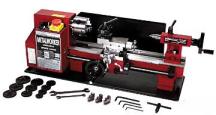 I decided to buy a 7″ X 12″ Microlux lathe from Micro- Mark. The cost was $569, about $70 above similar equipment from other sources, but this particular model is an inch, rather than millimeter machine, which is important to me. Shipping was $12, for the 75 lb item.
I decided to buy a 7″ X 12″ Microlux lathe from Micro- Mark. The cost was $569, about $70 above similar equipment from other sources, but this particular model is an inch, rather than millimeter machine, which is important to me. Shipping was $12, for the 75 lb item.
The sales people at Micro Mark were courteous, helpful and knowledgeable of their product line. The machine and accessories shipped within an hour or two of placing the order with the exception of one accessory, a collet set. I didn’t have an immediate need for the collect set anyway, and Micro Mark will pay freight when they fill this backorder.
A machine can’t function without tools, and these small low cost lathes don’t typically come with a lot of extras. In this case, accessories included were: 3 jaw self centering bolt on chuck, MT-2 dead center for tailstock, carriage power feed with change-gear set for threading, thread position indicator, splash guard, chip tray and instruction manual/parts diagram. To insure I could jump in there and get myself in trouble as soon as the machine arrived I added:
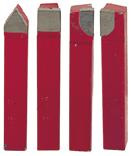
First on my list of options were carbide cutting and forming tools; 60° forming tool for threading, square for shoulder cutting, left hand roughing tool, and right hand cutting tool (direction determined by relief angle adjacent to the cutting surface). Not pictured, but included in the 11 piece set, finishing tools, and a narrow bladed cut off tool. Carbide was selected because they hold an edge longer and I am not skilled, as yet, in sharpening tools. Also, carbide is consistent with the turning speeds appropriate for the material I’ll be turning, stainless and carbon steel.
There is nothing fancy here, nothing that won’t be used. The cost was $35, which I thought might be a little expensive, but I found comparable tools across this variety to run from $2 for each simple roughing tool, to $5 for a single cut off blade. Even if there were a few dollars to save, in my view, the convenience and the opportunity to support a company that provided quality customer service would be worth the extra couple of bucks.
 Much of the ability, or inability, to hold a dimension along the length of a piece of turned stock is related to how little deflection of the part occurs under tool pressure, or as a result of centrifugal force acting on spinning thin stock. If the tool moves in against the stock by .015″, but the material deflects .003″ from the tool, the cut will only be .012″. Moving the tool along from a well supported piece of the stock held by the chuck or tailstock mounted center, to an unsupported center section, could result in a good deal of dimensional change along the length of the part.
Much of the ability, or inability, to hold a dimension along the length of a piece of turned stock is related to how little deflection of the part occurs under tool pressure, or as a result of centrifugal force acting on spinning thin stock. If the tool moves in against the stock by .015″, but the material deflects .003″ from the tool, the cut will only be .012″. Moving the tool along from a well supported piece of the stock held by the chuck or tailstock mounted center, to an unsupported center section, could result in a good deal of dimensional change along the length of the part.
The top right accessory, a follower rest, mounts to the carriage opposite the tool and follows it along the surface of the material being turned, working opposite the tool pressure and greatly reducing material deflection. The cost is $27. The accessory pictured lower right is a steady rest. It mounts to the lathe bed, so it is stationary support for the material and does not move with the cutting or forming tool. Round stock spins between the three point centers which reduces thin material deflection from centrifugal force and some applied tool pressure. This part runs approximately $30. Both accessory costs from Micro Mark are perhaps $2 higher than other suppliers, but the colors match and I can be pretty sure they will fit the lathe. I don’t have enough experience to know if this is an issue or not.

A four jaw chuck has got to be good, after all, that’s one more than a three jaw chuck. Right? Actually, I believe they serve two different purposes. Typically jaws of a three jaw chuck are reversible and move in unison; you close one, you close them all. These are good for general work, they are quick to set up and one that is not defective typically holds minimal run out. Yes, I frequently use the wrong terminology, but I will hopefully get better as my brain catches up to my mouth. Jaws of a four jaw chucks typically move independent of one another. With the use of a dial indicator to check run out, a four jaw will potentially result in less run out and a production part holding closer tolerance. In addition, a four jaw chuck can grasp irregular shapes and turn parts off center – although I’m not sure why the last capability is important as I understand tapers are the result of an off set tail stock.
In research it seems some chucks bolt directly to the headstock spindle, and headstock spindles are drilled in a variety of three, four and six hole patterns. Apparently three holes are a problem and won’t directly mount four jaw chucks without modification or a chuck adapter. As a general rule, adapters are something to avoid. They carry their own production tolerances and may introduce run out or out of flat conditions to a machine. This 4″ $79 chuck, and it’s three jawed cousin, bolt directly to the Microlux spindle. Again, cost is within a couple of dollars of other sources with similar product, although I am not familiar enough with various brands to differentiate based on quality. There can be some major differences in chuck prices based on source and brand.

$32 added a 1/2″ capacity tailstock Jacobs chuck, a handy accessory for drilling small holes where a boring tool would be inappropriate. The fit is an MT-2 taper, which is a standard, which could be said for virtually all of the other accessories. In short, the equipment is quite standard, so you won’t have to anticipate a future search for your closest Microlux lathe dealer for parts and accessories.
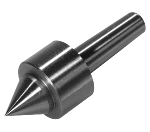
A ball bearing center added another $12 to the Micro Mark order. As the name sort of suggests, the center that supports the tailstock end of the material is mounted on ball bearings and turns with the stock. There is come confusion here with labels, I see ball bearing centers called live centers, live centers described as the spindle end driven center, so I will sort this out later. My intention in buying this ball bearing center was friction reduction on the tail stock end of the material being turned.
A good deal of where I expect to struggle with my first lathe machining excursions is in selection of the correct sequence of operations, and establishing the correct reference point to work from. When working around the home, you quickly learn that vertical lines should be plumb, horizontal components need to be perpendicular to plumb and level and an absolute reference is needed to prevent accumulative error. Machining seems to hold similar tenets.
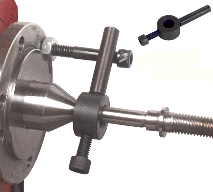 If you have a piece of metal with a central bore, and the external walls need to be concentric to that bore, you probably need to locate the material to be turned to the center of the bore to insure this outcome. Picture on the right, this stock has been located to its center, rather than gripped on the outside derivative surface by a chuck. A lathe dog, clamped to the material mounted between two non-driven centers, is driven by a bolt through the spindle face. This composite catalog shot from the Micro Mark, shows the lathe dog in the inset, and installed in the main picture. This was an inexpensive accessory at about $4, but I believe one that will come in handy with some frequency.
If you have a piece of metal with a central bore, and the external walls need to be concentric to that bore, you probably need to locate the material to be turned to the center of the bore to insure this outcome. Picture on the right, this stock has been located to its center, rather than gripped on the outside derivative surface by a chuck. A lathe dog, clamped to the material mounted between two non-driven centers, is driven by a bolt through the spindle face. This composite catalog shot from the Micro Mark, shows the lathe dog in the inset, and installed in the main picture. This was an inexpensive accessory at about $4, but I believe one that will come in handy with some frequency.
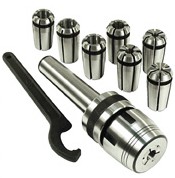
If you’ve been reloading for a while, or spent some time around almost any kind of machinery, you probably have used tools that employ a collets system. Draw in collect chucks are used with lathes for smaller stock, primarily round in shape. They accurately center work, each working within a narrow range of diameters. The Micro Mark set includes 1/8″, 3/16″, 1/4″, 5/16″, 3/8″, 1/2″, 9/16″ and 5/8″ collets. At $139, it was the most costly accessory, however, this set will also work with a milling machine that is part of a second coming article and this exploration into machining operations.
![]()
The last accessory I purchased was a 4 piece center drill set; drill # 0, 1, 2 and 4 at $24. My use for a center drill is primarily to open a hole, and a countersink, when stock is to be supported between two centers. The countersink will increase contact surface area with the tapered points of the lathe’s centers, and not burn up the center, or damage the stock with a hole that is too small in diameter or too shallow.
The reality is that I probably needed one center drill size, but I wasn’t sure which and, as my wife likes to sometimes remind me when she believes I’m lost, I just hate to ask for directions.
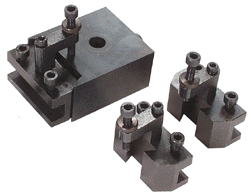 There are some things I didn’t buy, surprisingly. I passed on a digital read out, I think I can follow a printed motor speed matrix and I don’t need to watch an over priced tachometer. An adjustable cutter set seemed to introduce too many parts into the cutter holding equation, and I wasn’t sure when its use was applicable – that means through experience I will probably discover it is used constantly in routine operation.
There are some things I didn’t buy, surprisingly. I passed on a digital read out, I think I can follow a printed motor speed matrix and I don’t need to watch an over priced tachometer. An adjustable cutter set seemed to introduce too many parts into the cutter holding equation, and I wasn’t sure when its use was applicable – that means through experience I will probably discover it is used constantly in routine operation.
I passed on the quick change tool holder $55 (left), and an extra conventional tool holder, $35. It reminded me too much of the stack of turret lathe die holders and Ammo master quick change die holders I use mostly to hold open spring loaded doors. I noticed, after buying them, that I still insist on checking for proper die installed height even though these types of accessories are suppose to make that not necessary. I couldn’t imagine critical tool alignment would be held with quick change anything. My final exclusion was a face plate; couldn’t see when I would need this accessory at this time.
Conclusion
So that’s it…for now. I’m very much looking forward to the equipment showing up. I’m a little anxious, wondering if the stuff will show up in good shape, or pounded to death during shipment. Until everything arrives, I’m working on selecting a simple CAD package so I can convert some of my more abstract thoughts for projects to a plan I can actually follow and produce some parts. This is fun.
Thanks
Joe

Email Notification